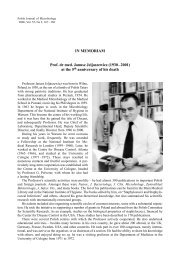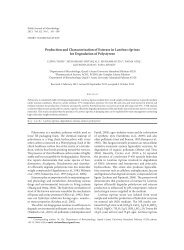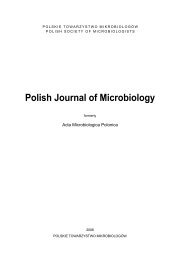No 3 - Polish Journal of Microbiology
No 3 - Polish Journal of Microbiology
No 3 - Polish Journal of Microbiology
You also want an ePaper? Increase the reach of your titles
YUMPU automatically turns print PDFs into web optimized ePapers that Google loves.
182<br />
PG classification system established by Schleifer and<br />
Kandler (1972). In some cases the differences may<br />
be quite extreme like, for example, the occurrence <strong>of</strong><br />
mostly (75%) A2pm → A2pm (i.e. 3 → 3) crosslinks in<br />
Clostridium difficile PG (Peltier et al., 2011)<br />
Variations in the structure <strong>of</strong> the glycan strands <strong>of</strong><br />
PG have recently been elegantly reviewed by Vollmer<br />
(2008). A review by davis and Weiser (2011) focuses<br />
specifically on the role <strong>of</strong> peptidoglycan modifications<br />
and their effects on the host immune response to infection.<br />
A unique modification <strong>of</strong> glycan strands is the<br />
presence <strong>of</strong> muramic δ-lactam, which occurs e.g. in<br />
the thick PG <strong>of</strong> Bacillus sp. and Clostridium sporogenes<br />
endospores. In Bacillus subtilis approximately every<br />
second MurNAc residue along the glycan strands is<br />
modified to muramic δ-lactam. The modification<br />
<strong>of</strong> MurNAc involves the action <strong>of</strong> two enzymes, the<br />
MurNAc deacetylase PdaA and the amidase Cwld.<br />
Studies with mutants lacking these enzymes have shown<br />
that intact endospores are formed but that the spores<br />
are not able to germinate since unmodified spore PG<br />
is not recognized by germination-specific hydrolases<br />
(Popham et al., 1996, Atrih and Foster, 2001; Gilmore<br />
et al., 2004). More recently, it has been demonstrated<br />
that in Bacillus anthracis germination is mediated<br />
by the action <strong>of</strong> germination-specific lytic enzymes<br />
(GSLEs), one <strong>of</strong> which is SleB. SleB functions independently<br />
as a lytic transglycosylase on both intact and<br />
fragmented cortex. Most <strong>of</strong> the muropeptide products<br />
that SleB generates are large and are potential substrates<br />
for other GSLEs present in the spore, such as a glucosaminidase<br />
that cleaves between N-acetylglucosamine<br />
and muramic-δ-lactam. SleB has two domains, the<br />
N-terminal domain is required for stable PG binding,<br />
while the C-terminal domain is the region <strong>of</strong> PG hydrolytic<br />
activity, which is dependent on cortex containing<br />
muramic-δ-lactam in order to carry out hydrolysis<br />
(dowd et al., 2008; Heffron et al., 2011).<br />
PdaA, mentioned above, is an example <strong>of</strong> several<br />
N-deacetylases found in different Gram-positive bacteria,<br />
which carry out the N-deacetylation <strong>of</strong> MurNAc or<br />
GlcNAc (or both) in polymerized PG. N-deacetylation<br />
<strong>of</strong> MurNAc was found to protect bacterial cell walls from<br />
degradation by lysozyme, an important factor <strong>of</strong> the<br />
innate immune system (Araki et al., 1971). These enzy-<br />
mes, which have a predicted extracytoplasmic location<br />
in the cell, have been thoroughly reviewed by Vollmer<br />
(2008). The N-deacetylase <strong>of</strong> Streptococcus pneumoniae<br />
(PgdA) has been shown to be a putative virulence factor<br />
(Vollmer and Tomasz, 2002). deacetylation <strong>of</strong> PG<br />
increases the positive charge <strong>of</strong> the cell wall, possibly<br />
contributing to protection <strong>of</strong> the pathogens against the<br />
binding <strong>of</strong> cationic antimicrobial peptides <strong>of</strong> the host<br />
organism. Similar observations were made more recently<br />
by Popowska et al. (2009) who found that a pgdA mutant<br />
Markiewicz Z. and Popowska M. 3<br />
<strong>of</strong> Listeria monocytogenes was more prone to autolysis<br />
and was more susceptible to cationic antimicrobial pep-<br />
tides, and by Meyrand et al. (2007) for Lactococcus lactis.<br />
In other studies, a mutant strain <strong>of</strong> L. monocytogenes<br />
lacking PdaA activity induced a massive IFN-beta response<br />
in a TLR2 and <strong>No</strong>d1-dependent manner and was<br />
rapidly destroyed within macrophage vacuoles (Boneca<br />
et al., 2007; Corr and O’Neill, 2009) and in bone-marrow<br />
derived macro phages, pgdA mutants <strong>of</strong> L. mono cytogenes<br />
demonstrated intracellular growth defects and<br />
increased induction <strong>of</strong> cytokine transcriptional respon-<br />
ses that emanated from a phagosome and the cytosol<br />
(Rae et al., 2011). In Streptococcus suis expression <strong>of</strong><br />
the pgdA gene was increased upon interaction <strong>of</strong> the<br />
bacterium with neutrophils in vitro as well as in vivo in<br />
experimentally inoculated mice, suggesting that S. suis<br />
may enhance PG N-deacetylation under these conditions.<br />
Evaluation <strong>of</strong> the pgdA mutant in both the Cd1<br />
murine and the porcine models <strong>of</strong> infection revealed<br />
a significant contribution <strong>of</strong> the pgdA gene to the<br />
virulence traits <strong>of</strong> S. suis (Fittipaldi et al., 2008). In an<br />
interesting study, it was found that neither PgdA inactivation<br />
nor PgdA overexpression in Lactobacillus lactis<br />
leading to different levels <strong>of</strong> PG deacetylation confers<br />
any advantage in the persistence <strong>of</strong> this bacterium in<br />
the gastrointestinal tract and its ability to enhance host<br />
immune responses (Watterlot et al., 2010). Bacterial<br />
N-deacetylases have been considered to be exported<br />
enzymes but it has recently been reported that some <strong>of</strong><br />
these enzymes may also be cytoplasmic, with a potential<br />
role in PG turnover and recycling (Popowska et al.,<br />
2011, for a very good review on turnover and recycling,<br />
see Reith and Mayer, 2011). A similar N-deacetylase<br />
lacking a signal peptide for secretion into the periplasmic<br />
space has been found in Helicobacter pylori (Shaik<br />
et al., 2011). The enzyme showed no in vitro activity on<br />
the typical polysaccharide substrates <strong>of</strong> peptidoglycan<br />
and results from crystallization and structure studies<br />
suggest that it binds a small molecule at the active site,<br />
even though the peptidoglycan <strong>of</strong> a HP0310 (syn. HpPgdA)<br />
knock-out mutant was characterized by higher<br />
degree <strong>of</strong> acetylation compared to the wild-type, along<br />
with increased susceptibility to lysozyme degradation.<br />
O-acetylation <strong>of</strong> MurNAc, similarly to N-deacetylation,<br />
is typically associated with bacterial resistance<br />
to lysozyme PG from degradation by lysozyme as well<br />
as by endogenous autolytic enzymes, e.g. the lytic transglycosylases.<br />
As a protective modification it is more<br />
ubiquitous than N-deacetylation and has been found to<br />
occur in many different bacterial species, both Grampositive<br />
and Gram-negative (Vollmer, 2008). An additional<br />
acetyl group is linked to the C6-OH <strong>of</strong> MurNAc<br />
to form a 2,6-N,O-diacetylo muramic acid residue. The<br />
ester bond <strong>of</strong> O-linked acetate is significantly weaker<br />
than the amide bond <strong>of</strong> N-linked acetate.






